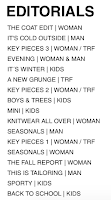LOCATION

For the clothing that is modelled in the clothing section is clearly shot in a studio, with a white colourama. The flooring is often different, with a white textured flooring, this is used in the accessories and shoe sections. However in the editorial sections, the shots are more creative and have different colouramas that suit the mood of the shoot. Some of which are set on location, one image is on a roof top building, with a neutral texture.
The clothes are the main focus here, if there are fussy backgrounds then it deflects the attention away from the selling point. I do think the location shots are very effective for the editorial, as the clothing hasn't been styled too much so that it is wearable. In the top left image, the burnt orange coat contrasts well against the neutral background. Even though white clothes are shown on the white background in the right image, it is still a strong image, and the customer can easily identify each garment, and still have an idea of how it can be styled. The backgrounds don't necessarily have any furniture in, apart from the accessories pages and the shoes. They are either placed on boxes, or the models are sat on wooden stools, its created more of a three dimension, rather than being a flat image. Every other image of the shoes/accessories are presented in a different way, either propped up against a box, or on a different coloured contrasted colourama.
HAIR


The hair is left very natural looking, natural hair colours, with a wave. In some circumstances the hair looks windswept. Perhaps a stylist is on call with cardboard to flap it creating a breeze to create some more movement in the image, or a wind machine could have been used on a low setting.
MAKE UP


As well as the hair, the make up is too very natural. Glossy skin, blushed cheeks, stained or moisturised lips, a lick of mascara and eyeliner. As Zara do not sell beauty products apart from fragrances, this website is highly based in clothing, therefore I feel that Zara wants to remain the attention on the clothing and nothing else.
MODELS
The models are very tall, slim, and natural looking. Their facial features are very soft, with a strong jaw line. The models ages range from 17-28 perhaps, they appear very youthful and fresh faced. Some with freckles, dark skin, pale skin, and mixed ethnicities. The facial expressions are quite serious, yet soft, some of them are quite flirtatious. From what I can see the models are not showing any tattoos. Quite sophisticated looking girls. The poses that the models do are not very far-fetched, they are relaxed, and are either walking, sat down, or have their hands in their pockets or by their side. There are a range of side profiles of the models, some looking straight into the camera and some looking away out of frame.
LIGHTING

The lighting is very bright, with a good even exposure and contrast, the models faces are not over exposed and the colour pay off is presented very well. There are hardly any shadows, apart from some of the still life images, however this looks effective as it makes the accessories and shoes look more real and not so static. There are no flash backs on some of the shinier materials, such as the bags and the patent leather shoes.
PRICES
With the customers having a mid-range income, the customer can spend more money, yet are getting their moneys worth by buying good quality garments at a low price. They can get more items of clothing instead of shopping around in different shops, Zara can cater for their needs, and provide them with a good shopping experience, both online and in store. Zara is classed as a 'designer boutique' store, however with a huge price difference to most boutiques. Even though H&M or Marks & Spencer are not luxury brands, they are still competitors within the same price range. It is about getting the balance right between high fashion and affordable prices.
PHOTOGRAPHY
In the clothing sections, the majority of the images are photographed front on, in a lookbook style. Depending on the item of clothing the images range from close ups (accessories), mid length (tops and outerwear) and full length images (trousers and dresses).
PHOTOGRAPHY
In the clothing sections, the majority of the images are photographed front on, in a lookbook style. Depending on the item of clothing the images range from close ups (accessories), mid length (tops and outerwear) and full length images (trousers and dresses).














